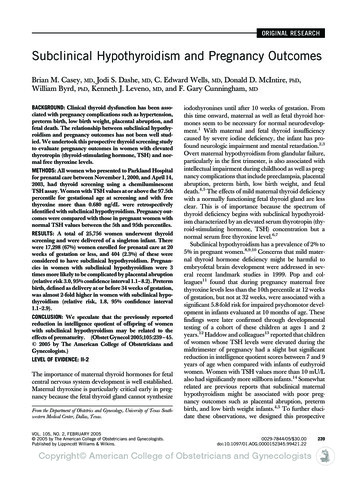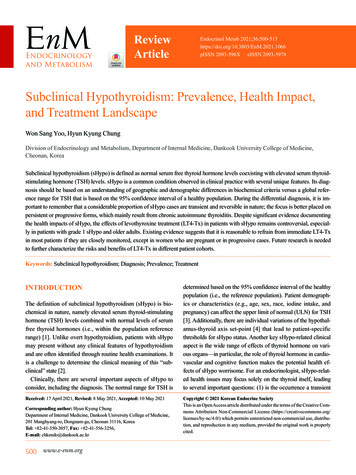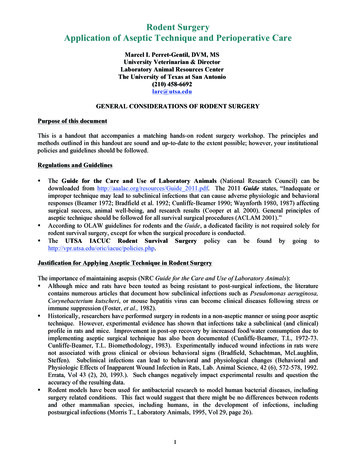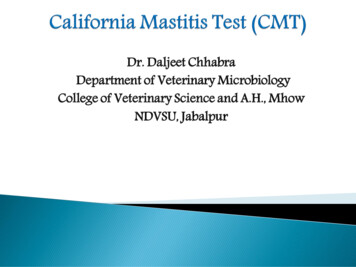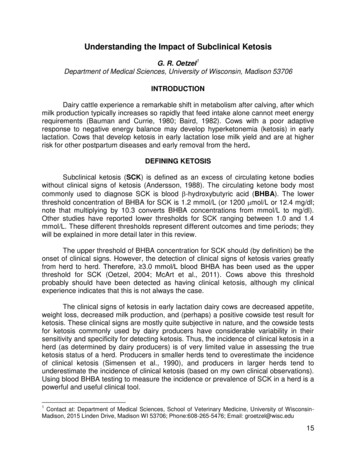
Transcription
Understanding the Impact of Subclinical KetosisG. R. Oetzel1Department of Medical Sciences, University of Wisconsin, Madison 53706INTRODUCTIONDairy cattle experience a remarkable shift in metabolism after calving, after whichmilk production typically increases so rapidly that feed intake alone cannot meet energyrequirements (Bauman and Currie, 1980; Baird, 1982). Cows with a poor adaptiveresponse to negative energy balance may develop hyperketonemia (ketosis) in earlylactation. Cows that develop ketosis in early lactation lose milk yield and are at higherrisk for other postpartum diseases and early removal from the herd.DEFINING KETOSISSubclinical ketosis (SCK) is defined as an excess of circulating ketone bodieswithout clinical signs of ketosis (Andersson, 1988). The circulating ketone body mostcommonly used to diagnose SCK is blood -hydroxybutyric acid (BHBA). The lowerthreshold concentration of BHBA for SCK is 1.2 mmol/L (or 1200 mol/L or 12.4 mg/dl;note that multiplying by 10.3 converts BHBA concentrations from mmol/L to mg/dl).Other studies have reported lower thresholds for SCK ranging between 1.0 and 1.4mmol/L. These different thresholds represent different outcomes and time periods; theywill be explained in more detail later in this review.The upper threshold of BHBA concentration for SCK should (by definition) be theonset of clinical signs. However, the detection of clinical signs of ketosis varies greatlyfrom herd to herd. Therefore, 3.0 mmol/L blood BHBA has been used as the upperthreshold for SCK (Oetzel, 2004; McArt et al., 2011). Cows above this thresholdprobably should have been detected as having clinical ketosis, although my clinicalexperience indicates that this is not always the case.The clinical signs of ketosis in early lactation dairy cows are decreased appetite,weight loss, decreased milk production, and (perhaps) a positive cowside test result forketosis. These clinical signs are mostly quite subjective in nature, and the cowside testsfor ketosis commonly used by dairy producers have considerable variability in theirsensitivity and specificity for detecting ketosis. Thus, the incidence of clinical ketosis in aherd (as determined by dairy producers) is of very limited value in assessing the trueketosis status of a herd. Producers in smaller herds tend to overestimate the incidenceof clinical ketosis (Simensen et al., 1990), and producers in larger herds tend tounderestimate the incidence of clinical ketosis (based on my own clinical observations).Using blood BHBA testing to measure the incidence or prevalence of SCK in a herd is apowerful and useful clinical tool.1Contact at: Department of Medical Sciences, School of Veterinary Medicine, University of WisconsinMadison, 2015 Linden Drive, Madison WI 53706; Phone:608-265-5476; Email: groetzel@wisc.edu15
INCIDENCE VERSUS PREVALENCE OF SUBCLINICAL KETOSISIncidence of Subclinical KetosisThe incidence of SCK in a herd is the number of new cases of SCK (blood BHBAbetween 1.2 and 2.9 mmol/L) that occurred during the risk period (early lactation)divided by the number of cows who completed the risk period. Most new cases of SCKoccur within the first 2 to 3 weeks after calving in herds that manage cows in groups andfeed a total mixed ration. Cows that are component-fed and housed in individual stallsappear to develop ketosis later (3 to 6 weeks after calving).The time period over which the incidence of SCK is measured must be specified(e.g., a week, a month, or a year). Determining the incidence of SCK requires repeatedtesting of cows throughout this risk period. Testing must occur twice or more weekly inorder to accurately assess the incidence of SCK. This is necessary because the mediantime for the resolution of SCK is about 5 days (McArt et al., 2011). If testing occurs onlyonce a week, a cow could potentially develop and resolve her SCK between testintervals (McArt et al., 2012a). Because of the need for repeated testing, the incidenceof SCK is usually determined only in research trials.Published studies that did repeated testing of early lactation cows report earlylactational incidence rates of ketosis between about 40% and 60% (Emery et al., 1964;Simensen et al., 1990; Duffield et al., 1998). These rates could have been even higherbecause some of these studies evaluated incidence based on once weekly blood BHBAtesting. We (my Cornell coworkers and I) reported an overall SCK incidence rate of43.2% for 1,717 cows in 4 large commercial herds (McArt et al., 2011). The SCKincidence ranged from 26.4% to 55.7% by herd. We also found that new cases of SCKoccur remarkably soon after calving; peak incidence was at 5 days in milk (DIM; seeFigure 1).Figure 1. Histogram of the incidence of SCK (first blood BHBA test between 1.2 to 2.9mmol/L) on any one of 5 or 6 tests between 3 and 16 DIM.16
Prevalence of Subclinical KetosisPrevalence is a ‘snapshot’ measure of the current SCK status of a group of cowsand is defined as the proportion of cows with blood BHBA concentrations between 1.2and 2.9 mmol/L at a given point in time. Repeated testing of individual cows is notnecessary for determining prevalence. It is usually done for a subset of the earlylactation cows within a herd. Herds can be tested repeatedly for SCK and the resultspooled into a cumulative prevalence; this increases the reliability of the estimate of theherd’s prevalence of SCK. For practical reasons, almost all herd-level evaluations forSCK are conducted as prevalence testing.The peak prevalence of SCK occurred at 5 DIM in the large field study (McArt etal., 2012a; see Figure 2). At 5 DIM, 28.9% of cows were positive for SCK. This findingunderscores the observation that SCK occurs very soon after calving.Figure 2. Histogram of prevalence of SCK in 1,717 Holstein dairy cows undergoingrepeated testing for ketosis from 3 to 16 DIM. A positive test for SCK was definedas a blood BHBA concentration of 1.2 to 2.9 mmol/L.Estimating the Incidence of Subclinical Ketosis from its PrevalenceAlthough the prevalence of SCK in a herd is much easier to determine than itsincidence, the incidence of SCK must be known in order to estimate the overall negativeimpacts of SCK on herd performance. Knowledge of the herd’s prior incidence of SCK isalso needed before determining the best ketosis testing strategy for a herd (McArt et al.,2012a).The repeated testing necessary to determine the incidence of SCK within a herdis daunting and requires testing a large number of cows twice weekly for about the firsttwo weeks of lactation. Fortunately, the incidence of SCK can be estimated from itsprevalence. The incidence of ketosis has been reported to be 2.2 X the prevalence17
(Duffield et al., 1998; Oetzel, 2004) and was 2.4 X the prevalence in our recent fieldstudy (McArt et al., unpublished data).NEGATIVE IMPACTS OF SUBCLINICAL KETOSISReduced Milk YieldThe negative impacts of SCK on milk yield are well-known. Estimates of milkyield loss due to ketosis represent the difference between ketotic and non-ketotic cowsand do not fully account for how much milk the ketotic cow might have produced hadshe not developed ketosis. Thus, actual milk lost may be underestimated because cowswith ketosis may have been higher producing cows prior to the onset of their ketosis.Previous studies have reported milk yield losses in ketotic vs. non-ketotic cows of2.2 to 3.1 lbs of daily milk (4.4 to 6.6%); a milk ketone test was used to diagnose ketosisin this study (Dohoo and Martin, 1984). Duffield et al. (2009) reported a 4.1 lb decrease(about 5.5%) in milk yield at first Dairy Herd Information Association (DHIA) test forcows with blood BHBA 1.4 mmol/L during the first week after calving. Ospina et al.(2010a) used a cutpoint of 1.0 mmol/L of blood BHBA to define SCK and reported thatcows ( lactation 2) with SCK lost 865 lbs of 305-day ME milk (about 7.0%). Chapinal etal. (2012) reported a 5.3 lb reduction in milk yield (about 6.9%) at the first DHIA test forcows with blood BHBA 1.4 mmol/L during the first week after calving.In our recent field study, cows (any parity) with SCK produced 2.6 lbs less dailymilk (about 3.4%) for the first 30 DIM compared to non-ketotic cows (McArt et al.,2012a). Early detection and treatment of SCK with propylene glycol (300 ml orally oncedaily until the ketosis resolved) improved milk production by about 1.5 lbs of daily milkcompared to cows whose SCK was left untreated (McArt et al., 2011).The severity of the milk yield loss due to SCK was associated with magnitude ofthe elevation in BHBA at the first diagnosis of SCK (McArt et al., 2012a). Eachadditional 0.1 mmol/L increase in BHBA (beyond 1.2 mmol/L) was associated with 1.1lbs more lost milk for the first 30 DIM. The difference between modest SCK (1.2 mmol/LBHBA) and more severe SCK (2.4 mmol/L) was 13.2 lbs of daily milk for the first 30 DIM(see Figure 3).Days in milk at the first onset of SCK also affects the severity of the milk yieldloss. Cows first diagnosed with SCK between 3 and 7 DIM produced 4.6 lbs less dailymilk (about 6.0%) in the first 30 DIM compared to cows first diagnosed with SCKbetween 8 and 16 DIM (McArt et al., 2012a). This was the first study to report thatearlier onset of SCK resulted in more detrimental effects to the cow. Other problemsassociated with SCK were more severe in cows that were first diagnosed between 3and 7 DIM; these will be discussed later in this review.Increased Risk for Early Lactation Removal18
In our recent field study, we reported that cows with SCK were 3.0 times (95% CI2.2 to 4.2) more likely to be removed from the herd (sold or died) in the first 30 DIMcompared to non-ketotic cows (McArt et al., 2012a). No previous studies have reportedthe effect of SCK on herd removal.Figure 3. Regression plot of mean predicted daily milk yield for the first 30 DIM by bloodBHBA concentration of first positive BHBA test (1.2 to 2.9 mmol/L) for 369Holstein dairy cows undergoing repeated testing for ketosis from 3 to 16 DIM.The solid line represents the best fit; 95% confidence intervals are shown foreach predicted milk yield by BHBA concentration.Increasing severity of ketonemia at the onset of SCK increased the risk for herdremoval in the first 30 DIM (McArt et al., 2012a). Each 0.1 mmol/L increase in BHBAincreased the risk for herd removal by 1.4-fold (95% confidence interval; CI 1.1 to1.8). For example, increasing blood BHBA at the onset of SCK from 1.2 to 2.4 mmol/Lincreased the risk for early lactation herd removal by 56.7 X (1.412). Note that this studyonly considered cows with blood BHBA 3.0 mmol/L; cows with higher BHBAconcentrations could have had an even greater risk for herd removal in the first 30 DIM.Early detection and treatment of SCK with oral propylene glycol reduces the riskfor early lactation removal. We reported that cows not treated for their SCK were 2.1times (95% CI 1.2 to 3.6) more likely to die or be sold by 30 DIM than cows treatedwith oral propylene glycol (McArt et al., 2012b).Increased Risk for Displaced AbomasumThe association of SCK with increased risk for displaced abomasum (DA) is wellestablished. Duffield et al. (2009) reported that blood BHBA 1.2 mmol/L in the firstweek after calving increased the odds for DA by 2.6 (95% CI 1.3 to 5.2). Ospina et al.(2010b) reported 6.9-fold higher risk for DA (95% CI 3.7 to 12.9) for cows withpostpartum BHBA 1.0 mmol/L. Interestingly, Chapinal et al. (2011) reported no effect19
of postpartum BHBA on the risk for DA, although elevated blood non-esterified fat acidand low blood calcium were associated with increased odds for DA.In our recent field study we found even more profound effects of SCK on the riskfor subsequent DA. Cows with SCK were 19.3 times more likely to develop asubsequent DA (95% CI 13.8 to 27.0). The very large risk ratio reported here reflectsthe very low rate of DA in non-ketotic cows in the study (0.3% in the non-ketotic cowsvs. 6.5% in the cows with SCK).We also reported that cows with more severe hyperketonemia at the onset oftheir SCK had increased risk for DA (McArt et al., 2012a). Each 0.1 mmol/L increase inBHBA at the first SCK-positive test increased the risk for developing a DA by a factor of1.1 (95% CI 1.0 to 1.2). A cow with an initial blood BHBA of 2.4 at the onset of herketosis would have a 3.1-fold (1.112) increased risk for a subsequent DA compared to acow with an initial BHBA concentration of 1.2 mmol/L at her first SCK diagnosis.Days in milk at the first onset of SCK also affects the risk for subsequent DA(McArt et al., 2012a). Cows who first developed SCK between 3 and 5 DIM were 6.1times more likely (95% CI 2.3 to 16.0) to develop a DA compared to cows first testingpositive for SCK between 6 and 16 DIM.Early detection and treatment of SCK with oral propylene glycol reduces the riskfor subsequent DA. We reported that cows not treated for their SCK were 1.6 times(95% CI 1.3 to 2.0) more likely to develop a DA than cows treated with oral propyleneglycol (McArt et al., 2012b).Increased Risk for MetritisDuffield et al. (2009) reported that blood BHBA 1.2 mmol/L in the first weekafter calving increased the odds for metritis 3.4-fold (95% CI 1.6 to 7.2). The authorssuggested that impaired immune function due to ketosis could explain the increased riskfor metritis. Ospina et al. (2010b) reported a 2.3-fold higher risk for metritis (95% CI 1.1 to 5.2) for cows with postpartum BHBA 0.7 mmol/L. We did not formally evaluatethe association between metritis and SCK in our recent field study (McArt et al., 2012a),but instead offered it to the models as a potential confounding variable. Becausemetritis occurs very soon after calving and may not be diagnosed promptly, it isparticularly difficult to infer whether the associations between SCK and metritis arecause or effect.Impaired FertilityAssociations between SCK and fertility have been inconsistent. Walsh et al.(2007) evaluated cows from mostly small and medium-sized herds in Ontario in 1990’sand reported that ketosis (defined as blood BHBA 1.0 mmol/L) in the first week aftercalving reduced the risk for pregnancy at first service (odds ratio 0.73, 95% CI 0.54to 0.99). In the second week after calving, ketosis (defined as blood BHBA 1.420
mmol/L) reduced the odds for pregnancy even more (odds ratio 0.60, 95% CI 0.40to 0.88). Ospina et al. (2010a) studied larger herds ( 250 cows) in New York in the late2000’s and found a less profound effect of ketosis on reproduction. They reported thatthe risk for pregnancy with 70 days of the voluntary waiting period tended to be lower(hazard ratio 0.87, P 0.10) for cows with blood BHBA 1.0 mmol/L after calving.Chapinal et al. (2012) followed cows from 55 herds (herd size 100 cows) from2006 to 2007 and found no association between blood BHBA before or after calving onfirst service conception rates. In our recent field trial in 4 large commercial dairies, wefound no overall effect of SCK on first service conception rates (McArt et al., 2012a).We did find that cows first diagnosed with SCK between 3 and 7 DIM were 0.7 times aslikely to conceive at first service (95% CI 0.6 to 0.8) compared to cows first testingpositive between 8 and 16 DIM. We also reported reduced pregnancy rates by 150 DIMfor cows that first developed their SCK earlier in lactation.Early detection and treatment of SCK with oral propylene glycol increases firstservice conception. We reported that cows with SCK who were treated with oralpropylene glycol were 1.3 times (95% CI 1.1 to 1.5) more likely to conceive at firstinsemination than control cows (McArt et al., 2012b).Economic Impacts of Subclinical KetosisThe economic impact of SCK can be quantified, but is dynamic and dependenton the expected milk yield loss, feed costs, feed efficiency, expected increase in theoccurrence of postpartum diseases, the background incidence of these diseases,expected costs of these diseases, expected increase in early lactation herd removals,slaughter value of sold cows, disposal costs of dead cows, treatment costs for sickcows, and the cost of herd replacements. Duffield (2000) estimated the cost of a case ofSCK to be 50 CAD to 100 CAD, which is approximately US 46 to US 92 whenadjusted for inflation and the exchange rate. Geishauser et al. (2001) derived a similarestimate of 78 CAD per case of SCK (approximately 68 USD after adjusting forinflation and the exchange rate). We are currently working on detailed models toestimate the cost of a case of SCK based on the results from our recent field trial.The high incidence of SCK, in combination with even a moderate cost per case,results in very high overall costs to the dairy producer. We have seen large variations inherd-level incidence of SCK (from about 25 to 60%), which suggests that there areimportant economic opportunities in most dairy herds.COWSIDE BLOOD BHBA TESTING WITH A HAND-HELD KETOMETEROur understanding of SCK and the ability of veterinarians and dairy producers todiagnosis ketosis has been greatly enhanced by the availability of a rapid and accuratecowside test for blood BHBA. The Precision Xtra meter (Abbott Laboratories) wasdeveloped to measure either whole blood BHBA or whole blood glucose in humanpatients. As far as we know, no other human glucometer can also function as a21
ketometer (i.e., able to measure blood BHBA). The Precision Xtra meter givesexcellent results for measuring whole blood BHBA in cows. No additional calibration oradjustment from the human system is needed.The Precision Xtra ketone monitoring system is a simple and directelectrochemical test (which may explain why it works well for both human and bovineblood). The ketone test strip contains the enzyme β-hydroxybutyrate dehydrogenase,which oxidizes BHBA to acetoacetate. This reduces nicotinamide adenine dinucleotide(NAD ) to NADH. The NADH is then reoxidized to NAD by an electron transfermediator molecule. The electrical current generated by this conversion is measured bythe meter and is directly proportional to the BHBA concentration.These meters retail in human pharmacies for about 80 USD. Veterinarysuppliers carry the meters for about 50 each. The blood ketone test strips (whichmeasure BHBA) are sold in boxes of 10 strips each. Veterinary suppliers sell these forabout 13 to 15 for a box of 10 strips, or 1.30 to 1.50 per test. Human suppliers willtypically sell them for about 4.00 to 5.00 per strip. Most pharmacies do not stock theblood ketone strips routinely but can order them for you.The BHBA results on blood from cattle are surprisingly accurate using thePrecision Xtra system. Three initial studies (Burke et al., 2008; Oetzel and McGuirk,2008; Iwersen et al., 2009) all gave very similar results. These studies involved a total of622 cows with a 14.1% prevalence of ketosis. The average coefficient of determination(R2) between hand-held meter and laboratory BHBA results was 0.94. The hand-heldmeter was 91% sensitive and 94% specific for diagnosing ketosis (pooled results fromall three trials). The positive predictive value for the meter was 73% and the poolednegative predictive value was 98%.The most recent evaluation of the Precision Xtra blood ketone system showedexceptionally high sensitivity and specificity ( 98%) for ketosis diagnosis (Oetzel, 2010)using the threshold of 1.3 mmol/L. The R2 between hand-held meter and laboratoryBHBA results was 0.86, which was lower than for previous reports. This may have beenthe result of the cold conditions during this study. Although the meter and strips can beused as a cowside test year-round, it is important to keep the meter and strips as warmas possible (e.g., in an inside pocket) during cold weather.The most rewarding use of cowside blood BHBA testing is for herd-based ketosismonitoring. Strategies for herd-based testing have been explained in detail (Oetzel,2004). The cowside BHBA test with the hand-held meter can be used in place ofsubmitting serum or plasma samples to a laboratory for BHBA testing. In summary, theprotocol involves testing 12 or more cows in early lactation. If more than 10% of thecows tested have blood BHBA 1.2 mmol/L) the group is considered to have a ketosisproblem.22
CONCLUSIONSSubclinical ketosis in dairy herds can be described by its incidence (theproportion of cows that develop SCK anytime in early lactation) and by its prevalence(the proportion of cows with SCK at any given point in time). Incidence is very difficult todetermine because it requires repeated testing of individual cows. Prevalence is mucheasier to determine; the incidence can then be estimated from the prevalence.The costs of SCK in affected cows are substantial and include lost milk yield (upto about 7%), increased risk for herd removal in early lactation, and increased risk fordisplaced abomasum. The effect of SCK on metritis is difficult to evaluate because bothconditions occur at the same time. The effect of SCK on subsequent fertility isinconsistent and appears to be small. Cows affected with SCK earlier in lactation or withhigher BHBA concentrations experience more negative effects. The total economic lossfor a single case of SCK is between about 46 and 92 USD. Early detection of SCKusing a cowside blood test followed by treatment of SCK with oral propylene glycolreduces the negative impacts of SCK.ACKNOWLEDGEMENTSThe majority of the research data presented in this paper and the resultingclinical insights originated from my research collaborations with Drs. Jessica McArt andDaryl Nydam at the College of Veterinary Medicine, Cornell University. This researchwas sponsored by Boehringer Ingelheim Vetmedica, Inc. (St. Joseph, MO) and by theUS Department of Agriculture - National Research Initiative. We are indebted to thedairy producers in New York and in Wisconsin who provided us access to their cowsand records, and to the many veterinary students and veterinarians who assisted us indata collection.REFERENCESAndersson, L. 1988. Subclinical ketosis in dairy cows. Vet. Clin. North Am. Food Anim.Pract. 4:233-251.Baird, G. D. 1982. Primary ketosis in the high-producing dairy cow: Clinical andsubclinical disorders, treatment, prevention, and outlook. J. Dairy Sci. 65:1-10.Bauman, D. E., and W. B. Currie. 1980. Partitioning of nutrients during pregnancy andlactation: A review of mechanisms involving homeostasis and homeorhesis. J.Dairy Sci. 63:1514-1529.Burke, C. M., K. E. Leslie, and L. M. Neuder. 2008. Test comparison of Precision Xtraand Ketostix for ketosis in dairy cows. Page 287 in Proc. 41st Annu. Conf., Am.Assoc. Bov. Pract. AABP, Auburn, AL.Chapinal, N., M. Carson, T. F. Duffield, M. Capel, S. Godden, M. Overton, J. E. Santos,and S. J. LeBlanc. 2011. The association of serum metabolites with clinicaldisease during the transition period. J. Dairy Sci. 94:4897-4903.23
Chapinal, N., M. E. Carson, S. J. LeBlanc, K. E. Leslie, S. Godden, M. Capel, J. E.Santos, M. W. Overton, and T. F. Duffield. 2012. The association of serummetabolites in the transition period with milk production and early-lactationreproductive performance. J. Dairy Sci. 95:1301-1309.Dohoo, I. R., and S. W. Martin. 1984. Subclinical ketosis: prevalence and associationswith production and disease. Can. J. Comp. Med. 48:1-5.Duffield, T. 2000. Subclinical ketosis in lactating dairy cattle. Vet. Clin. North Am. FoodAnim. Pract. 16:231-253.Duffield, T. F., K. D. Lissemore, B. W. McBride, and K. E. Leslie. 2009. Impact ofhyperketonemia in early lactation dairy cows on health and production. J. DairySci. 92:571-580.Duffield, T. F., D. Sandals, K. E. Leslie, K. Lissemore, B. W. McBride, J. H. Lumsden, P.Dick, and R. Bagg. 1998. Efficacy of monensin for the prevention of subclinicalketosis in lactating dairy cows. J. Dairy Sci. 81:2866-2873.Emery, R. S., N. Burg, L. D. Brown, and G. N. Blank. 1964. Detection, occurrence, andprophylactic treatment of borderline ketosis with propylene glycol feeding. J.Dairy Sci. 47:1074-1079.Geishauser, T., K. Leslie, D. Kelton, and T. Duffield. 2001. Monitoring for subclinicalketosis in dairy herds. Compend. Contin. Educ. Pract. Vet. 23:S65–S71.Iwersen, M., U. Falkenberg, R. Voigtsberger, D. Forderung, and W. Heuwieser. 2009.Evaluation of an electronic cowside test to detect subclinical ketosis in dairycows. J. Dairy Sci. 92:2618-2624.McArt, J. A., D. V. Nydam, and G. R. Oetzel. 2012a. Epidemiology of subclinical ketosisin early lactation dairy cattle. J. Dairy Sci. 95:5056-5066.McArt, J. A., D. V. Nydam, and G. R. Oetzel. 2012b. A field trial on the effect ofpropylene glycol on displaced abomasum, removal from herd, and reproductionin fresh cows diagnosed with subclinical ketosis. J. Dairy Sci. 95:2505-2512.McArt, J. A., D. V. Nydam, P. A. Ospina, and G. R. Oetzel. 2011. A field trial on theeffect of propylene glycol on milk yield and resolution of ketosis in fresh cowsdiagnosed with subclinical ketosis. J. Dairy Sci. 94:6011-6020.Oetzel, G. R. 2004. Monitoring and testing dairy herds for metabolic disease. Vet. Clin.North Am. Food Anim. Pract. 20:651-674.Oetzel, G. R. 2010. Evaluation of the hand-held Precision Xtra system for diagnosingketosis in early lactation dairy cows. J. Dairy Sci. 93 (E-Suppl 1):526.Oetzel, G. R., and S. M. McGuirk. 2008. Evaluation of a hand-held meter for cowsideevaluation of blood beta-hydroxybutyrate and glucose concentrations in dairycows. Page 234 in Proc. 41st Annu. Conf., Am. Assoc. Bov. Pract. AABP,Auburn, AL.Ospina, P. A., D. V. Nydam, T. Stokol, and T. R. Overton. 2010a. Association betweenthe proportion of sampled transition cows with increased nonesterified fatty acidsand beta-hydroxybutyrate and disease incidence, pregnancy rate, and milkproduction at the herd level. J. Dairy Sci. 93:3595-3601.Ospina, P. A., D. V. Nydam, T. Stokol, and T. R. Overton. 2010b. Evaluation ofnonesterified fatty acids and beta-hydroxybutyrate in transition dairy cattle in thenortheastern United States: Critical thresholds for prediction of clinical diseases.J. Dairy Sci. 93:546-554.24
Simensen, E., K. Halse, P. Gillund, and B. Lutnaes. 1990. Ketosis treatment and milkyield in dairy cows related to milk acetoacetate levels. Acta Vet. Scand. 31:433440.Walsh, R. B., J. S. Walton, D. F. Kelton, S. J. LeBlanc, K. E. Leslie, and T. F. Duffield.2007. The effect of subclinical ketosis in early lactation on reproductiveperformance of postpartum dairy cows. J. Dairy Sci. 90:2788-2796.25
SESSION NOTES26
lactation. Cows that develop ketosis in early lactation lose milk yield and are at higher risk for other postpartum diseases and early removal from the herd. DEFINING KETOSIS Subclinical ketosis (SCK) is defined as an excess of circulating ketone bodies without clinical signs of ketosis (Andersson, 1988). The circulating ketone body most


